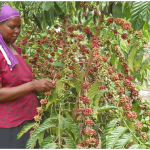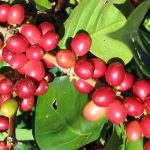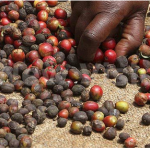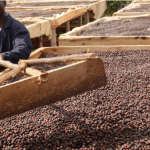Sometimes farmers grow coffee and intercrop it with two or more crops on the same land. This is commonly done in western Uganda; in districts such as Mbarara, Bushenyi, Rukungiri, Mitooma, and Ntungamo.
The reasons for intercropping range from lack of enough land, utilising the spaces between the coffee trees, and to some extent, a need to harvest two or more crops from the same piece of land. At times, the crops may thrive while others, due to some factors, may not grow well.
Proper spacing
Eliab Baryakashanga, a farmer in Rukungiri District, notes that crops that grow well when intercropped with coffee include soya, beans and groundnuts. This is because they are short rooted and do not compete with coffee.
“If a farmer is to mix coffee with bananas, the banana should be placed eight feet apart for Arabic coffee and ten feet apart for Robusta coffee to avoid competition for soil nutrients,” he advises.
Baryakashanga, however, notes that intercropping with soya, beans and groundnuts should only be done when the coffee is young.
When bananas are more than coffee, chances are that the nutrients for coffee may get depleted, compared to when the coffee trees are more than bananas.
“When intercropping bananas with coffee, a farmer should skip three coffee plants on both sides and then plant a banana,” he says.
Competition for nutrients
Yoram Ruraza, also a farmer from Rukungiri District, adds that other crops that may be intercropped with coffee are maize and sorghum because they mature faster than coffee. This creates room for it to grow well.
“What should be considered is that when intercropping either Arabic or Robusta coffee with these crops, it should be at least more than three years old. When it is younger than three years, it (coffee) may cause them to wither because when growing, coffee uses a lot more soil nutrients compared to maize and sorghum,” Ruraza points out.
When intercropped or not, he advises that the weeding should be done manually and not with a hoe as some farmers mistakenly do.
“When you use a hoe, you end up cutting the roots of the coffee plant, which may make it not grow well. The roots, as it grows, spread out to reach soil nutrients in different directions,” he notes.
Also, as Leonald Kasigazi, Rukungiri District agricultural officer, points out: “If a farmer is to mix coffee with crops such as soya and beans, they should minimise the number of these crops as coffee is the priority. This is for soil and water conservation to prevent soil exhaustion.”
Arabica coffee grows well in sandy loam soils when intercropped with plants such as bananas. But this is not the case with Robusta because just like bananas, it is also a shallow rooted feeder crop.
“When you plant Robusta in the same garden as bananas, it takes up a lot of water from the soil. It is recommended that bananas be intercropped with Robusta coffee when it is more than four years old,” Kasigazi says.
Higher income
Because coffee is a shade loving plant, it should be planted with certain trees to provide shades and protect it from sunshine.
When a farmer intercrops certain types of trees and bananas with coffee, he or she benefits from the food as the coffee also benefits from the shade provided by the bananas and the trees.
There is also good utilisation of labour as a farmer will work on all the crops simultaneously,” Kasigazi says, adding that when a farmer does it as recommended, they also earn higher income.
Banana-coffee: a smart mix
Growing coffee and banana together generates more income for smallholder farmers, and can help them cope with effects of climate change. Farmers get 50 per cent more income from intercropping than from growing either crop alone, according to a study by International Institute of Tropical Agriculture (IITA).
The study, conducted in over 30 districts, showed that coffee yield remained the same. But when intercropped with bananas, the farmers gained additional income from the banana.
In the Arabica coffee-growing region around Mt Elgon, annual returns per hectare averaged $4,441 (Shs12.6m) for coffee and banana grown together, compared to $1,728 (Shs4.9m) and $2,364 (Shs6.7m) for mono-cropped banana and coffee, respectively. In Robusta-growing areas in the south and south-west, annual returns per intercropped hectare averaged $1,827 (Shs5.2m), compared to $1,177 (Shs3.3m) and $1,286 (Shs3.6m), respectively, for banana and coffee alone.
Another study, conducted by IITA and International Centre for Tropical Agriculture, suggests that intercropping may also help farmers cope with climate change pressures.
Average temperatures are expected to increase by two degrees Celsius in the coming decades, with more erratic rainfall. This could have a considerable effect on coffee production.
Coffee generates about 20 per cent of the total export revenues. Eighty per cent of the coffee grown is Robusta, which grows at altitudes up to 1,500 metres. Arabica accounts for 20 per cent of the coffee grown, and for one-third of export revenue from coffee. Arabica requires a particularly cool tropical climate found at higher altitudes, generally above 1,400 metres.
Results from the study suggest that if systems are not adapted, areas below 1,300 metres will likely become unsuitable for Arabica. Those between 1,300-1,700 metres will be compromised, if farmers do not change current practices and make use of water conservation and shade technologies.
Intercropping provides a promising alternative, however. Shade from taller banana trees can reduce temperatures for coffee plants by two degrees Celsius or more. The permanent canopy, root systems and mulch from banana prevent soil erosion and degradation. What is more, planting banana in coffee fields also helps to mitigate climate change by capturing carbon dioxide from the air and through the mulch, enriching the soil’s carbon stocks.
Anecdotal evidence suggests that planting coffee in the shade of bananas may improve quality of the beans. Coffee planted with banana has been found to have a 50 per cent lower incidence of leaf rust than unshaded plants, which is important as pest and disease risks are rising with increasing temperatures.
With these advantages, the researchers also investigated why intercropping is not widespread. The downside is that it increases competition for water, nutrients and light. This competition needs to be managed by using good agronomic practices. The results could further tap the potential of banana-coffee systems to improve productivity and profitability, increase food and income security, and help adapt to climate.








